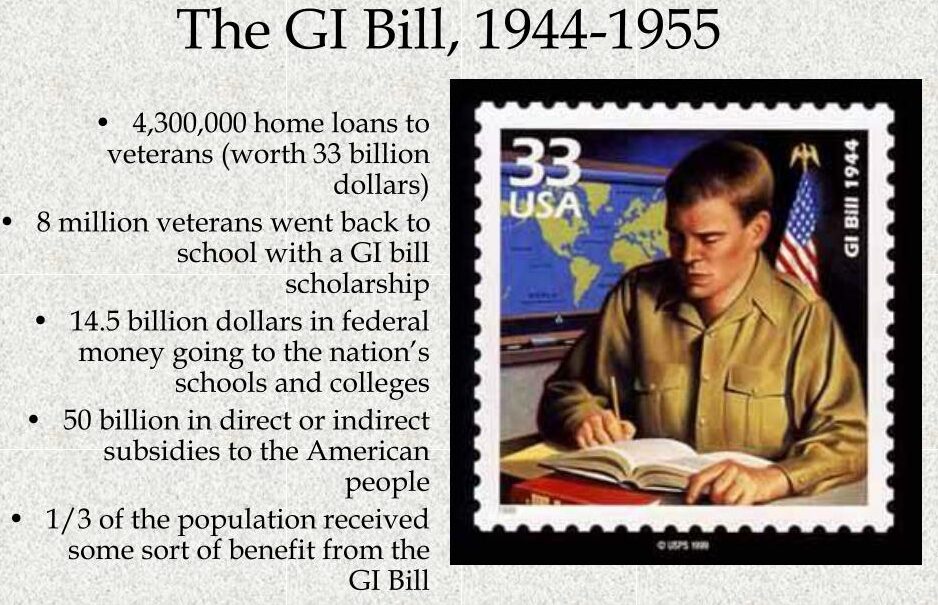FDR’s GI Bill Helped Create America’s Middle Class

One shining moment in American history commemorates the notion that government can be a force for good.
We have taught our youth to wage war. [W]e must now also teach them how to live useful and happy lives in freedom, justice and dignity.
President Franklin D. Roosevelt, October 27, 1943
Soon after Allied troops stormed the beaches of Normandy and D-Day turned the tide of World War II, President Franklin D. Roosevelt signed the Servicemen’s Readjustment Act of 1944, popularly known as the GI Bill, to assist returning American soldiers. This summer, we celebrate its 80th anniversary.
The GI Bill was a decisive factor in creating the American middle class. It provided millions of veterans with grants for education and training so that they could earn a living wage. Low-cost housing and small business loans helped post-war families achieve “the American Dream.”
The Drum Beat of Human Progress

Of course, other laws or policies have shaped America’s prosperity and unique destiny. Briefly:
- The Morrill Land-Grant College Act of 1862. The law provided land for public higher education and equipped states to build roads, bridges, canals, and other infrastructure.
- The Nineteenth Amendment to the US Constitution gave women the right to vote in 1919.
- The National Labor Relations Act of 1935, called the Wagner Act, protected a worker’s right to join a labor union and bargain collectively.
- The Social Security Act of 1935 was a landmark in American history.
- The Interstate Highway Act of 1956 boosted interstate commerce and transformed the American landscape.
- The Civil Rights Act of 1964 and Voting Rights Act of 1965, aimed to restore democracy’s promise that “all men are created equal.”
- The Medicare and Medicaid Acts of 1965 provided a lifeline to our nation’s elderly.
- The National Environmental Policy Act of 1969 sought a federal mandate for clean air and clean water.
- The Affordable Care Act (ACA) of 2010 suggested that health care was a right, not a privilege.

What About our Veterans?Â
As World War II wound down and victory was in sight, President Roosevelt and veterans groups were properly concerned about the prospects of millions of returning soldiers. Weighing heavily on FDR was the memory of returning World War I veterans and their bonus marches and skirmishes with US security forces that left two marchers dead and the veterans’ encampment in Washington, DC burnt to the ground.
Roosevelt was determined to rewrite the script. In 1940, a high school diploma was a rare achievement, attained by about 25% of Americans. The Armed Forces needed soldiers who could read and write. Accordingly, the government in 1943-44 embarked on a literacy program that achieved an 85% graduation rate among soldiers, including a large number of African-American soldiers.
This literacy program would come in handy for what would lie ahead when the war was over.
The GI Bill
President Roosevelt counted on the American Legion to write a benefits package for returning World War II veterans. The two main features of the Legion’s proposal were:
- Home or business loans. The government guaranteed 50% of the loan for up to $2,000, at no more than 4% interest.
- Education benefits. Grants of $500 a year for four years for education or technical tuition, plus a subsistence allowance of $50 a month ($75 for married veterans).
When Roosevelt signed the bill on June 22, 1944, it was assumed that the home and business loans would be the hot item. Few predicted that returning vets would jump at the chance to sit at a wooden desk in a classroom.
How wrong they were.
An Education Bonanza
During the first six years of the original GI Bill, over 2.2 million veterans attended a college or university while 5.6 million vets chose on-the-job training, correspondence schools, or simply the completion of high school. All told, 49 percent of returning World War II soldiers signed up for GI Bill benefits.
At first, some colleges, most notably Harvard and the University of Chicago, balked at the idea and feared their educational standards would be compromised. But for most institutions of higher learning, the GI Bill was manna from heaven. Most of them added new classes, hired new professors, added summer semesters, and built new dormitory space.
Notably, private universities for the first time welcomed Jews, Catholics, children of immigrants, and students who were the first from their families to go to college.
The first GI Bill ended in 1956. Variations followed.
Disclosure: Your faithful author enjoyed the benefits of the 1966 Vietnam Era GI Bill. By then, the VA paid veterans a monthly stipend to cover books and living expenses. I was grateful for the monthly check.
This website, on too few occasions, has covered veterans’ issues. Here are the links:
Is President Trump and three cronies Running the VA from his Mar-a-Lago country club?
Conservative dream of VA privatization is opposed by most veterans groups.
A report on the 2014 VA wait-time “scandal” and the real reasons it happened.



















































































































